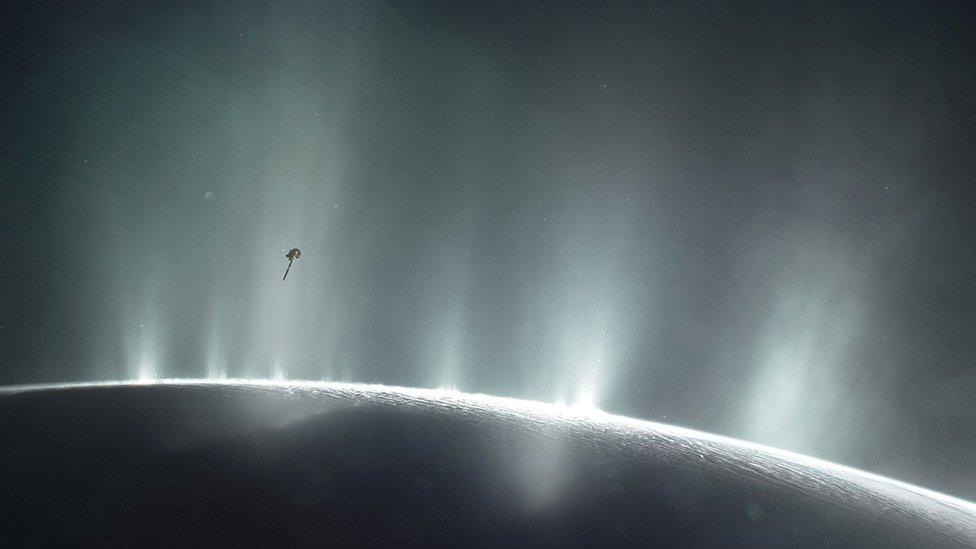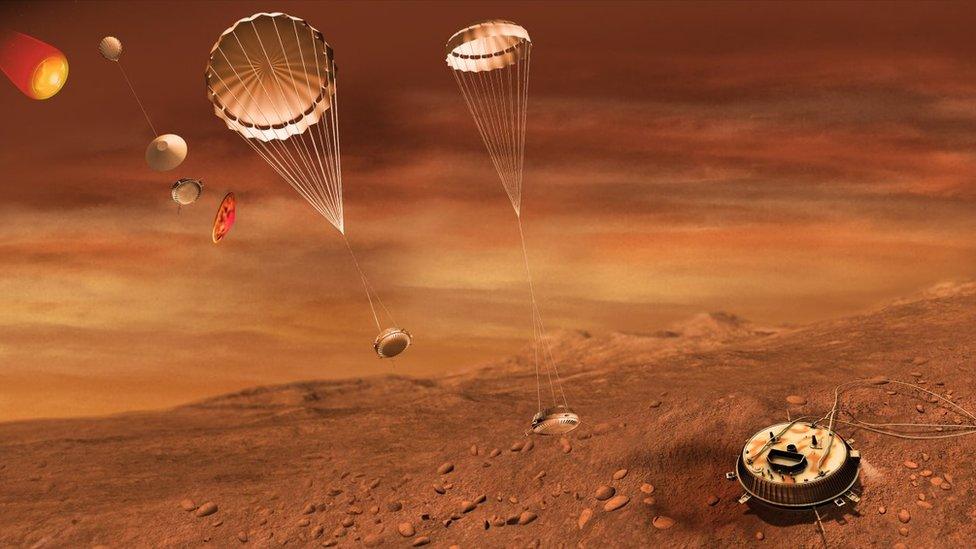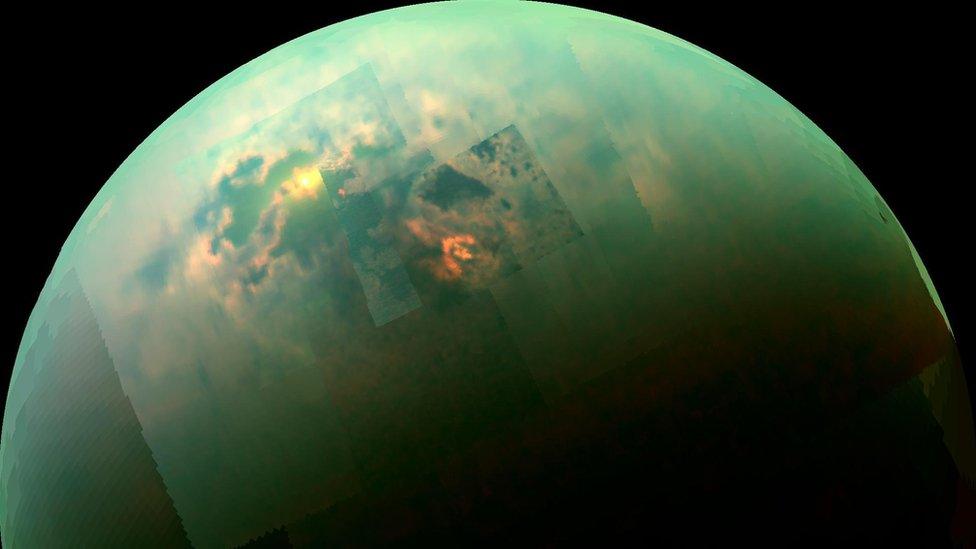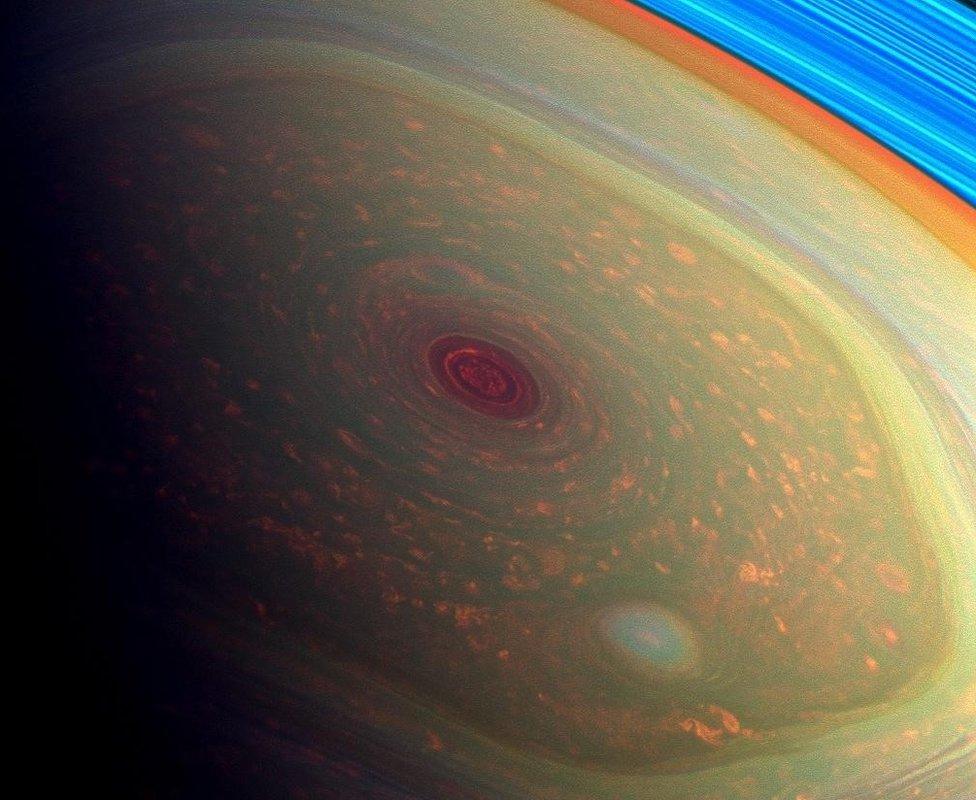Highlights from the Cassini-Huygens mission
- Published
The Cassini spacecraft spent 13 years exploring the Saturn system. In 2005, it deployed a probe, known as Huygens, to the surface of Titan.
Here is a selection of science highlights from the international mission.
Gushing geysers

Artwork: Cassini at Enceladus
Images sent back by the Voyager missions in the 1980s showed that Saturn's 500km-wide moon Enceladus had a very smooth, and therefore relatively young, surface that might be renewed by some unknown process. But it took Cassini to discover the geysers of water-ice shooting out from the little moon's south pole.
The water gushes out at 1,300km per hour through vents that are connected to a salty ocean below the ice shell. Water is considered an essential ingredient of life as we know it, making Enceladus a target in the search for alien biology.
Furthermore, by flying through the jets of water, as well as Saturn's E ring (which is made of material from those jets), and "tasting" them with an onboard instrument, Cassini was able to detect the presence of rocky grains, methane and molecular hydrogen.
The most likely explanation for these findings was the presence of fluid vents on the ocean floor. On Earth, these hydrothermal vents, which spew superheated water from below the seabed, teem with life.
Enceladus revealed that habitats for life may be more common than we thought, putting our own existence into a new perspective.

Landing on Titan

Artist's impression of the Huygens landing
On 14 January 2005, the European-built Huygens landing probe sailed down through the dense atmosphere of Saturn's biggest moon Titan. After powering up in the early hours, Huygens hit the top of the atmosphere (at an altitude of 1,270km).
Huygens survived hypersonic entry, deploying its parachute and collecting data as it floated towards the ground for two hours and 27 minutes. With its suite of onboard instruments, Huygens sent back pictures and profiled the atmosphere of Titan, including its temperature, pressure, density and composition.
"There was an atmospheric layer where the winds dropped to zero at 60 to 70km, picking up further down," Huygens project scientist Dr Jean-Pierre Lebreton told BBC News. "This has still not been explained properly."
The probe sent back data from the surface for another 90 minutes until Cassini - which was relaying the data to Earth - disappeared over the horizon. It remains the furthest from Earth a spacecraft has even landed.

Same-but-different moon

Cassini and Huygens revealed Titan as a through-the-looking-glass version of Earth. Its surface temperature of -179C means that liquid hydrocarbons take up many of the roles played by water on our planet. Titan has a seasonal cycle, with winds, methane rain and seas, mountains of ice and dunes of "plastic" sand.
Three dark methane seas are found at Titan's north pole - the biggest of which, Kraken mare, is larger than North America's Lake Superior. Surrounding these seas are numerous smaller bodies of liquid.
Cassini spotted tiny waves rolling across the surface of one sea, and a mysterious feature on another that has been dubbed the "magic island". Icebergs, waves and gas bubbling up from the seabed are all possible explanations for this latter phenomenon.
Titan also has some extraordinarily complex organic chemistry going on in its atmosphere. Indeed, some scientists think it might mimic the atmosphere that nurtured life on the very early Earth - offering a glimpse into our primordial past.
Enceladus wasn't the only moon found to have an ocean; Titan is also believed to have a body of liquid below its surface. But this ocean is probably composed of water mixed with ammonia.

Dynamic rings

Cassini revealed that Saturn's system of rings was an active and dynamic environment. In fact, the rings are a laboratory for how planets form around young stars. Scientists think the way embedded moons make gaps in the rings might mirror the way larger bodies formed from the disc of dust and gas that orbited the Sun billions of years ago.
Cassini observed previously unknown structures in the rings known as "propellers" and witnessed the possible birth of a small moon. Data from the mission might finally start to answer one of the biggest mysteries about Saturn - how and when the rings formed.
In 2017, just before the mission ended, scientists announced preliminary findings which suggested they were relatively young - perhaps 100 million years old. This might mean that we just happen to be living at a special time in history when Saturn has rings.

Storm force

The "hexagon" - an air current at Saturn's north pole
The Nasa spacecraft observed gigantic storms at both of Saturn's poles. To put things in perspective, the behemoth of a hurricane spinning at Saturn's north has an eye that's 2,000km (1,250 miles) wide. That's about 50 times larger than the average hurricane on Earth. Wind speeds here could be as fast as 150 m/s.
The eye of the north polar storm swirls within a mysterious and striking six-sided current of "air". No-one is quite sure how this hexagonal jet stream formed - nothing like it has ever been seen on another world.
However, using computer simulations, scientists have been able to show how such features might form through the interaction of different air currents. Unlike hurricanes on Earth, which typically last for days, this storm has existed for decades, at least, and perhaps centuries.